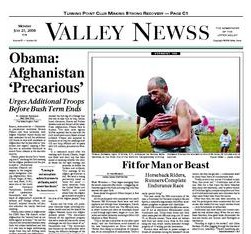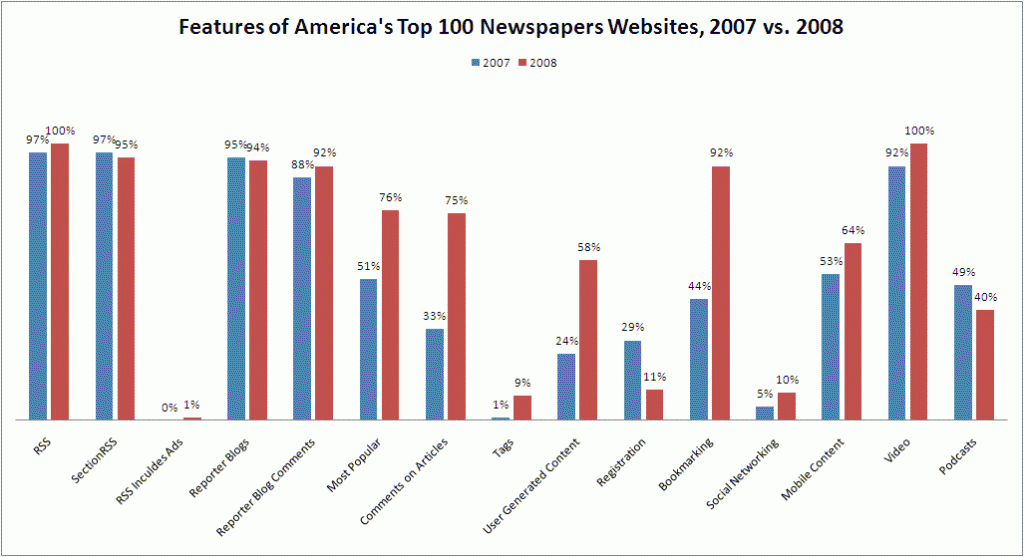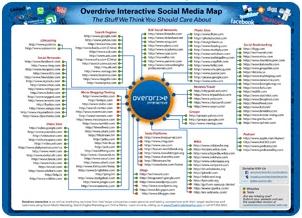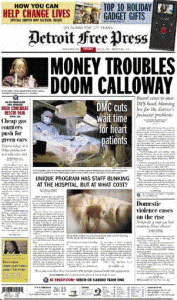We sorted through our 147 entries of 2008 to come up with the stories that surprised us, delighted us or made us shake our heads in disbelief. We’ll present them as a series of posts over the next few days in hopes that you’ll find them to be as memorable as we did. Happy New Year!
Management Ineptitude
The Cleveland Plain Dealer wrote a case history for the how not to handle a layoff. Staff were told not to come in to work until after 9:30 a.m. on Dec. 2. Laid-off employees were notified by phone. Those who didn’t get a call were expected to promptly come to the office. Management then arranged for laid-off employees to clean out their desks on a Saturday morning and to enter the building from the back where they wouldn’t attract the attention.
In March, Tribune Co. CEO Sam Zell was caught on video telling one of his reporter employees, “F**k you.” He muttered the comment under his breath at the end of a response to an Orlando Sentinel’s reporter’s pointed question about how newspapers can thrive by giving readers what they want when all readers want is stories about puppy dogs.
The Chinese Daily News had to pay $5.2 million for allegedly forcing reporters to file five stories a day and to rush between news conferences and interviews. Ad quotas were unreasonably high and production workers were forced to labor nonstop. Reporters testified that they had to work six days a week, 12 hours a day, but weren’t able to complain because of pressure and the culture of intimidation.
Several publishers chose Valentine’s Day to announce major layoffs.
The Denver alternative weekly Westword reported that staff members of the Longmont, Colo. Times-Call newspaper were invited to the publisher’s holiday party – as parking valets. Staffers reportedly earned what they got for their day jobs, only they spent their time parking the cars of rich people in attendance.
Los Angeles Times publisher David Hiller hatched a plan to move the paper’s monthly magazine completely under the control of the advertising department without telling the newspaper’s editor. Hiller reportedly hired a new editor and planned to replace the magazine’s entire nine-person editorial staff without telling anyone on the editorial side. Hiller resigned a few weeks later.
In June, Tribune Co. launched a campaign to measure journalist productivity by the number of column inches of copy they produced. Noting that Los Angeles Times reporters turn out about one-sixth as many column inches as their counterparts in Hartford or Baltimore, Tribune COO Randy Michaels issued a warning to writers and editors. “When you get into the individuals, you find out that you can eliminate a fair number of people while eliminating not very much content,” he said.
Slate’s Jack Shafer analyzed the use of anonymous sources by major newspapers. He created a few Google Alerts to look for words like “anonymity” and then looked at the stories to see if the secrecy was warranted. In most cases, he found that that the anonymous quotes were either obvious, self-serving or contributed nothing to the story.
Killing the Host
The Newspaper Guild in Honolulu printed up 100,000 cards for readers can send in to cancel their subscriptions in event of a strike. The thinking was that it was better to take down the Advertiser and cause a whole lot more people to lose their jobs than to have 54 employees treated unfairly.
The union at the Los Angeles Times mounted a campaign to drive out of existence the dwindling number of businesses that advertised in the paper because it said the Times wouldn’t negotiate in good faith.
Oh-Oh
A Google search bot triggered a 75% plunge in shares of United Airlines over the weekend when it assigned a Sept. 6, 2008 date to a six-year-old story about United Airlines’ bankruptcy filing.
 Editors at the Wine Spectator bestowed a coveted Award of Excellence on a non-existent restaurant. The prank was dreamed up by Robin Goldstein, who concocted a fake website with recipes from an Italian cookbook and a reserve wine list “largely chosen from among some of the lowest-scoring Italian wines in Wine Spectator over the past few decades.”
Editors at the Wine Spectator bestowed a coveted Award of Excellence on a non-existent restaurant. The prank was dreamed up by Robin Goldstein, who concocted a fake website with recipes from an Italian cookbook and a reserve wine list “largely chosen from among some of the lowest-scoring Italian wines in Wine Spectator over the past few decades.”
The Tampa Bay Tribune quickly backtracked on a series of design changes as some 300 readers canceled subscriptions and more than 3,000 called or wrote e-mails of protest. “Turns out, we had really disrupted the way people communicate with each other in the morning,” said executive editor Janet Coats.
The San Francisco Examiner caught a delivery man for the Palo Alto Daily Post apparently stealing copies of the Examiner as he delivered his own newspaper. When confronted and asked to open his trunk, the man had more than 1,000 copies of the rival newspaper stashed there.
The Chicago Sun-Times ran a contest for the best reader-submitted video opposing Sam Zell’s proposal to sell naming rights to the Chicago Cubs. The winner was a college student who interns at the rival Tribune. The Trib had some fun with winning its rival’s contest in this clip, which also includes the winning video.








 No doubt there will be lots of analysis and reaction to follow. We see that Gannett Blog has logged 70 comments in the first four hours. We’ll keep an eye out. In the meantime, we couldn’t help taking a snapshot of the ad that appeared on the Detroit News‘s account of today’s announcement. Perhaps a cleansing is exactly what’s needed.
No doubt there will be lots of analysis and reaction to follow. We see that Gannett Blog has logged 70 comments in the first four hours. We’ll keep an eye out. In the meantime, we couldn’t help taking a snapshot of the ad that appeared on the Detroit News‘s account of today’s announcement. Perhaps a cleansing is exactly what’s needed.

